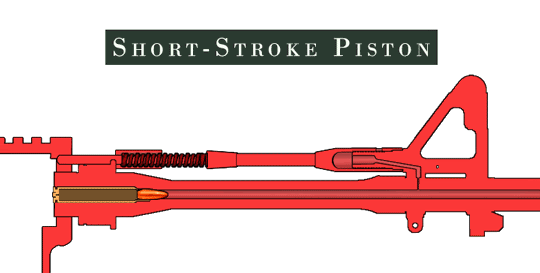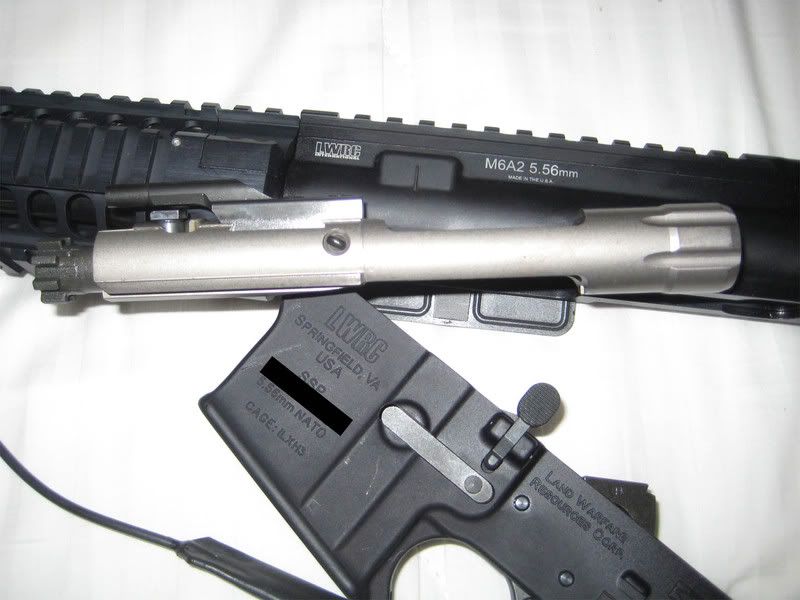But I think the main reason I want the system is the way it looks, not going to lie the gas-piston system is nice, but worthless for someone like me who is just firing at ranges and in the desert sometimes, If something goes wrong its not like ive got people shooting at me. That being said, thats why i wouldnt spend the $5-6000 people want for these, but I had no idea that it wasnt compatable with a normal ar-15 lower, So just for kicks and giggels how much work would be needed to make the 416 upper work with an ar-15 lower?
The price for the uppers should come down later this year when the MR556 is released. Unfortunately I found that as of right now the receiver pin has infact been moved on the american model as well, HK still wanting the uppers to only be used on thier guns. I cant imagine the guns being more then 2K-3K, but you never know, especially when they first come out. I'm (wishfully) thinking (err..hoping) it will be priced around the LWRC M6A2's price of 2200. But it looks like it's now coming to America late this year.
http://www.hkpro.com/documents/HK-MR-RIFLES-011409.pdf
As for finding out what you need to make an HK416 upper work with a semi auto lower, you are better off going to HKPRO and asking. there are plenty of people there that have done it. below is the link to the 416/417 thread.
http://hkpro.com/forum/forumdisplay.php?f=118
I Must State - I Am Biased Here!
However in my 'Day Job' I Am An Engineer and If Most of You Look Down At Your Computer, That Little 'Logo' On It Stating 'Something Inside' Is What I Make Everyday!
But when speaking on the best piston AR weapon System Out There It's LWRC Hands Down! This will work with ANY Mil-Spec AR Lower, Providing the lower has an H2/H3 Buffer / Spring. Only the Carrier in the Bolt Carrier group is proprietary, as is well as the gas piston system!

It utilizes a fixed piston (referred to as the “nozzle”), and a reciprocating cylinder (refered to this as the “piston cup”) that fits over the nozzle. The piston system is very lightweight, there are no adverse effects on barrel harmonics. The gas system also integrates a “staged vent” of gasses used to operate the system. That means the system does not vent supersonic gasses in one violent dump. Instead it vents progressively more sub-sonic gasses as the piston cup moves to the rear with a final dump of low-pressure gas. This was done to smooth the transmission of the kinetic energy applied by the piston system of the action of the rifle to prevent the likelihood of the extractor tearing through the rim on the cartridge. The practical effect of this is a very soft recoil impulse and near elimination of muzzle rise thus allowing very fast follow up shots. The rifle will work without issue even if the user does not adjust the gas when using a suppressor. The system only uses the gas required to cycle the action, no more, no less. Not so with the 'other' design of the piston on the end rod.
LWRC uses a bolt carrier key that functions as the anvil for the operating rod to impact on. This key is dovetailed into the bolt carrier for optimum strength. There are 5 reasons for this design,

1. The key like other components of the gas system is made out of a very strong, impact resistant alloy typically used in aerospace programs or landing gear components and heavy load gears and cogs for the same reasons LWRC selected it. The iron base is alloyed principally with a large percentage of nickel to produce a very specific heat-treatment product. The result is a steel which:
* Possesses high strength and toughness
* Allows for easy machining with minimal distortion
* Has uniform, predictable shrinkage during heat treatment
* Can be easily nitrocarburized
* Resists corrosion and crack propagation
2. The dovetail interface with the bolt carrier transmits the force over a larger area on the carrier and makes the entire assembly far stronger. Another reason for the key is that it is replaceable.
3. It allows for a shorter operating rod. The longer the operating rod, the more potential for it to bend, and the more difficult it is to manufacture straight, especially during heat treating.
4. There is a very slight downward slope on the key. In piston operated rifles, the action is being pushed off axis, not in a straight line like a direct gas impingement rifle, therefore it wants to tilt and can / will result in wear on the receiver. Something LMT, POF, HK eventually shows signs of, again merely by design.With the downward slope on the key, the forces are re-vectored ensuring the carrier is pushed straight back in the receiver.

5. The end of the operating rod is fully supported by the receiver bushing where it enters the open space of the receiver. They designed this operating rod to be fully supported as it impacts the bolt carrier key (anvil). In other words, it is counter to good design to have an inch of the operating rod hanging out inside the receiver un-supported. It is more likely to bend and disable the rifle. Again NOT to slam HK, However an example of this is the HK 416. The operating rod of the 416 is unsupported inside the receiver. To do this requires a much thicker operating rod for strength which HK has incorporated, but this also required they raise the height of the receiver to accommodate it. This results in a system that has a nonstandard picatinny height over bore axis requiring special mounts to keep the height of the optics on the same height over bore axis as the M4. Since the LWRC system is self-regulating for various gas pressures and volumes, the gas port erosion problem encountered by the M4A1 is no longer an issue in the M6A2.
The LWRCI gas system was designed so that it cannot be assembled incorrectly!
Notice in the 2nd picture above of the BCG, the rear of the carrier is grooved for maritime operations which some of you may know as the 'Over The Beach' capability. Plainly stated the rifle is capable of firing with a barrel full of water should the environment you are might be submerged and are experiencing a SHTF situation. The inside of the upper receiver has ports as well allowing the liquid to be expelled as we all know what Pascals Law States! Again NOT recommended but possible should you need to in order to save your life.
Identical to the HK the barrel is cold hammer forged. However NOT like the HK The standard M6 barrel features a ferritic salt bath nitro carburized interior and exterior finish. This finishing process is also applied to the barrel extension and gas port. This finishing process is a surface conversion process in place of industrial hard chrome and is therefore inherently free from nodules, flaking, pits, stripping, or anode burrs. The process results in chemical and structural composition changes that can be described as a case hardening to a depth of 0.005” of the alloy leading to increased surface hardness, lower coefficient of friction, enhanced surface lubricity, improved running wear performance, increased sliding wear resistance, enhanced corrosion resistance and heat resistance over industrial hard chrome. Since the process is a surface conversion and does not add material to the internal dimension of the bore, the barrels can be hammer forged on size over a very precise polished rifle mandrel. With hard chrome, the bore must be manufactured oversized or honed and electro-polished to make the interior dimension oversized making room for the chrome plating. This plating is inconsistent which is the reason sniper or target barrels are typically not chromed but solid stainless. Nitrocarburizing has proven superior as a surface finish to phosphating to oxidization when subjected to MIL-STD-810f salt fog/spray testing and is a scratch resistant flat black finish. The process is used by Sig Arms for use in their carbines. More notably Glock uses the process in their pistol bores as we all know with excellent results.
Having considered the facts and researching the hell out of this for well over a year now.
For What You Pay - For What You Get - LWRC Can Not Be Beat!
http://www.lwrifles.com/Products/M6A2/t ... fault.aspxDon't Think About It - Just Do It,,,